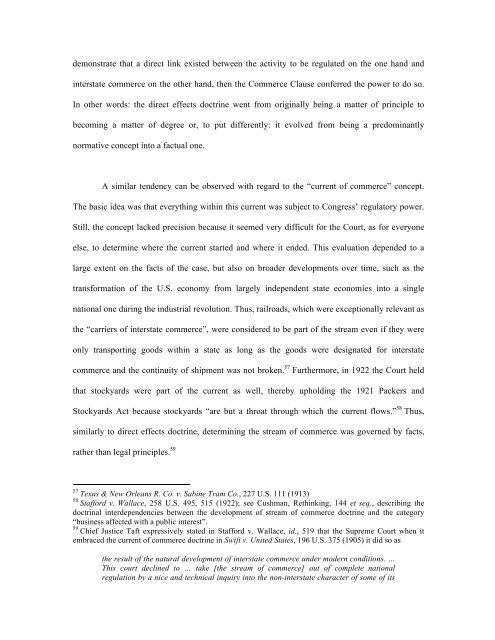Jasper Finke, Crisis and Law - New York University School of Law
Jasper Finke, Crisis and Law - New York University School of Law
Jasper Finke, Crisis and Law - New York University School of Law
Create successful ePaper yourself
Turn your PDF publications into a flip-book with our unique Google optimized e-Paper software.
demonstrate that a direct link existed between the activity to be regulated on the one h<strong>and</strong> <strong>and</strong><br />
interstate commerce on the other h<strong>and</strong>, then the Commerce Clause conferred the power to do so.<br />
In other words: the direct effects doctrine went from originally being a matter <strong>of</strong> principle to<br />
becoming a matter <strong>of</strong> degree or, to put differently: it evolved from being a predominantly<br />
normative concept into a factual one.<br />
A similar tendency can be observed with regard to the “current <strong>of</strong> commerce” concept.<br />
The basic idea was that everything within this current was subject to Congress’ regulatory power.<br />
Still, the concept lacked precision because it seemed very difficult for the Court, as for everyone<br />
else, to determine where the current started <strong>and</strong> where it ended. This evaluation depended to a<br />
large extent on the facts <strong>of</strong> the case, but also on broader developments over time, such as the<br />
transformation <strong>of</strong> the U.S. economy from largely independent state economies into a single<br />
national one during the industrial revolution. Thus, railroads, which were exceptionally relevant as<br />
the “carriers <strong>of</strong> interstate commerce”, were considered to be part <strong>of</strong> the stream even if they were<br />
only transporting goods within a state as long as the goods were designated for interstate<br />
commerce <strong>and</strong> the continuity <strong>of</strong> shipment was not broken. 57 Furthermore, in 1922 the Court held<br />
that stockyards were part <strong>of</strong> the current as well, thereby upholding the 1921 Packers <strong>and</strong><br />
Stockyards Act because stockyards “are but a throat through which the current flows.” 58 Thus,<br />
similarly to direct effects doctrine, determining the stream <strong>of</strong> commerce was governed by facts,<br />
rather than legal principles. 59<br />
57 Texas & <strong>New</strong> Orleans R. Co. v. Sabine Tram Co., 227 U.S. 111 (1913)<br />
58 Stafford v. Wallace, 258 U.S. 495, 515 (1922); see Cushman, Rethinking, 144 et seq., describing the<br />
doctrinal interdependencies between the development <strong>of</strong> stream <strong>of</strong> commerce doctrine <strong>and</strong> the category<br />
“business affected with a public interest”.<br />
59 Chief Justice Taft expressively stated in Stafford v. Wallace, id., 519 that the Supreme Court when it<br />
embraced the current <strong>of</strong> commerce doctrine in Swift v. United States, 196 U.S. 375 (1905) it did so as<br />
the result <strong>of</strong> the natural development <strong>of</strong> interstate commerce under modern conditions. …<br />
This court declined to … take [the stream <strong>of</strong> commerce] out <strong>of</strong> complete national<br />
regulation by a nice <strong>and</strong> technical inquiry into the non-interstate character <strong>of</strong> some <strong>of</strong> its
















